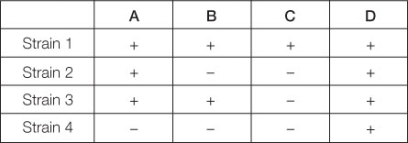Use the following to answer questions :
Suppose that a wild-type bacterium can synthesize substance D,but various mutant strains cannot.We know that substance D is synthesized from substance X in a pathway that involves three intermediate substances (A,B,and C) ,but we do not know the order of the steps in the pathway.Below is a table of four different mutant strains that have been tested for their ability to grow on the various substances.The plus sign means that the strain can grow on that substance;the negative sign means that the strain cannot grow on that substance. 
-Suppose that another strain (strain 5) can grow on substance B but cannot grow on substance C.What can we infer from this observation?
A) Strain 5 cannot grow on substance A.
B) Strain 5 cannot grow on substance D.
C) Strain 5 has a defect in the enzyme that converts substance B to substance C.
D) Strain 5 has a defect in the enzyme that converts substance B to substance D.
E) Strain 5 has a defect in the enzyme that converts substance C to substance B.
Correct Answer:
Verified
Q5: Which discovery caused the modification of the
Q6: In bacteria,_ kind(s)of RNA polymerase catalyze(s)the synthesis
Q7: Tetracycline,but not penicillin,is able to kill MRSA
Q8: Which molecule(s)is/are not required for transcription?
A) A
Q9: Which statement about the flow of genetic
Q10: The adapters that allow translation of the
Q11: RNA polymerase is a
A) polysaccharide.
B) lipid.
C) protein.
D)
Q12: What is the most likely reason that
Q14: Use the following to answer questions :
Suppose
Q15: Which type of molecule transfers information from
Unlock this Answer For Free Now!
View this answer and more for free by performing one of the following actions

Scan the QR code to install the App and get 2 free unlocks

Unlock quizzes for free by uploading documents